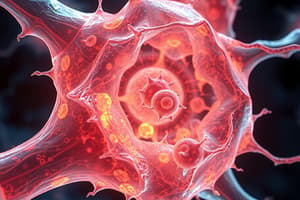Podcast
Questions and Answers
根據文章內容,考古學家在希臘的愛琴海島嶼上發現了哪些物品?
根據文章內容,考古學家在希臘的愛琴海島嶼上發現了哪些物品?
- 陶器碎片、工具和人骨 (correct)
- 建築遺跡和雕塑
- 古老的武器和飾品
- 金錢和寶石
島嶼環境對於骨骼保存面臨哪些挑戰?
島嶼環境對於骨骼保存面臨哪些挑戰?
- 極端溫度、鹽水和紫外線輻射 (correct)
- 溫度過高和過低
- 空氣污染
- 淡水侵蝕
研究島嶼上的人骨有什麼實際意義?
研究島嶼上的人骨有什麼實際意義?
- 提供人類演化和適應的寶貴見解 (correct)
- 發現新的礦物資源
- 揭示島嶼上的宗教信仰
- 幫助我們了解古代文明的軍事實力
根據文章,哪些因素影響了$尼爾島居民的骨骼結構和密度$?
根據文章,哪些因素影響了$尼爾島居民的骨骼結構和密度$?
根據上下文,以下哪項陳述是正確的?
根據上下文,以下哪項陳述是正確的?
以下哪項不是研究島嶼人骨遺骸所面臨的挑戰?
以下哪項不是研究島嶼人骨遺骸所面臨的挑戰?
Flashcards are hidden until you start studying
Study Notes
Bones Focused on Subtopics: Islands
Bone is a tissue composed primarily of collagen fibers embedded in a mineralized matrix of calcium phosphate. It plays a crucial role in supporting the body's structure, protecting vital organs, and serving as a storage site for minerals like calcium. Studying bones on islands provides unique insights into human evolution, migration, and adaptation to various environments throughout time.
Discoveries on Islands
One notable example of a significant island bone discovery is "Eve of Naharon," an 80% complete human skeleton found off the coast of Mexico in underwater caves along the Caribbean Sea. Dating back to approximately 13,600 years, she is considered the oldest known North American skeleton. Her discovery provides valuable information about the lifestyles and adaptations of early American inhabitants.
Additionally, skeletons dating between 9,000 to 13,000 years old have been discovered in underwater caves along the Yucatan Peninsula in Mexico. These discoveries offer researchers insights into prehistoric populations and their interactions with the environment.
Cultural Significance
In the context of cultural anthropology, bones serve as physical remnants of past civilizations. The study of these remains helps us understand the customs, beliefs, and practices of ancient societies. For instance, pottery fragments, tools, and human bones found on islands like Mykonos and Delos in Greece shed light on the daily lives of early Mediterranean settlers.
Preservation Challenges
Islands often pose unique challenges when it comes to preserving bone remains. Exposure to harsh environments, such as extreme temperatures, saltwater, and UV radiation, can degrade bone tissue over time. However, advancements in archaeological techniques and forensic science have allowed researchers to better understand and mitigate these preservation issues.
Bone Health and Island Life
On a more practical level, studying bones on islands can also inform our understanding of bone health and its relationship to environmental factors. For example, research based on the skeletons of the Polynesian island of Niue has demonstrated that diet, physical activity, and climate play significant roles in shaping bone structure and density.
In conclusion, bones found on islands offer invaluable insights into human history, evolution, and adaptation. These discoveries not only contribute to the fields of biology and anthropology but also highlight the importance of preserving and studying these remnants to better understand our past and present.
Studying That Suits You
Use AI to generate personalized quizzes and flashcards to suit your learning preferences.




